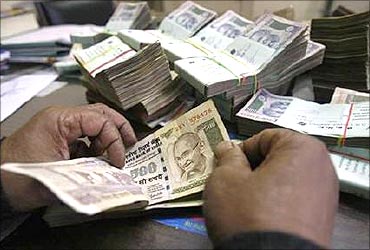 | « Back to article | Print this article |
Oil prices, deficit to keep rupee weak
High crude oil prices, widening current account gap and political uncertainty may keep the rupee weak in the near term even as the currency changed tack for the first time in two days and appreciated 0.2 per cent in Wednesday's trade.
There are near-term pressures (on the rupee) from the high current account deficit and oil prices. We expect the rupee to be in the range of 45-46. But if the unrest in West Asia continues and if oil touches $150 a barrel, then the rupee may touch 48-49 levels," V Balakrishnan, chief financial officer of Infosys Technologies, told Business Standard.
On Wednesday, the rupee closed at 45.01 per $1 as crude oil retracted from its 29-month high of $104.42 a barrel.
Economists and analysts, however, reckon that gains in the domestic currency may be capped in the short term as oil prices are expected to rise due to supply shortage amidst an extended period of crisis in West Asian and North African countries.
"If oil prices continue to stay high, the rupee might depreciate to 47.00-47.50 levels by June-July. This will also be the time when the first round of the impact of high oil prices on growth will be felt," said HDFC Bank's chief economist Abheek Barua.
Click NEXT to read more...
Oil prices, deficit to keep rupee weak
India's current account gap widened to 3.7 per cent of gross domestic product in the first six months of this financial year. This was the first time since 1991 that the current account deficit expanded to over 3 per cent. India's current account deficit is expected to be around 3.5 per cent in 2010-11 (April-March).
"Investors are likely to turn their focus to India's political uncertainties and the significant risks posed by higher oil prices to India's inflation, current account and fiscal outlook. This would impinge on capital flows to India," said Priyanka Chakravarty, an analyst with Standard Chartered.
Chakravarty also pointed out that the remittance flow to India typically rises in March, which provides some support to the exchange rate for the rupee.
Click NEXT to read more
Oil prices, deficit to keep rupee weak
Standard Chartered expects the rupee at 45.00 per $1 by March-end and to depreciate further to 46.20 by June-end.
Analysts and exporters, however, expect the rupee to strengthen in the second half of the current calendar year as inflation is likely to moderate and growth in the domestic economy is expected to gather pace.
"Over the medium term, however, we continue to have an overweight foreign exchange rating for the rupee. This is primarily because we expect the external balance to improve in the rupee's favour as the year progresses on the back of relatively better fundamentals," said Standard Chartered analyst Chakravarty.
Standard Chartered sees the rupee at 44.50 per $1 by December-end.
"It is difficult to predict the movement of the rupee. It is likely to remain volatile. I expect it to remain in the range of 45.00-45.50 this year," said Rostow Ravanan, chief financial officer of MindTree.




